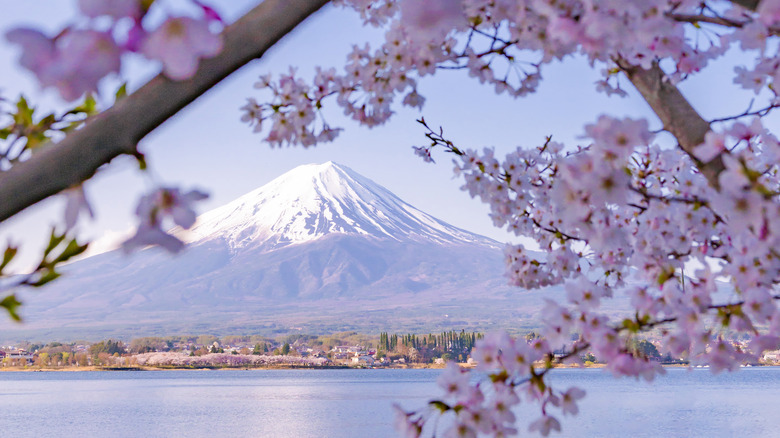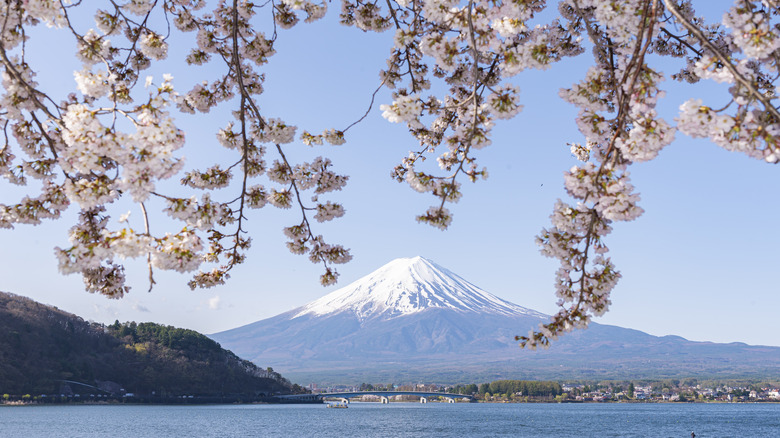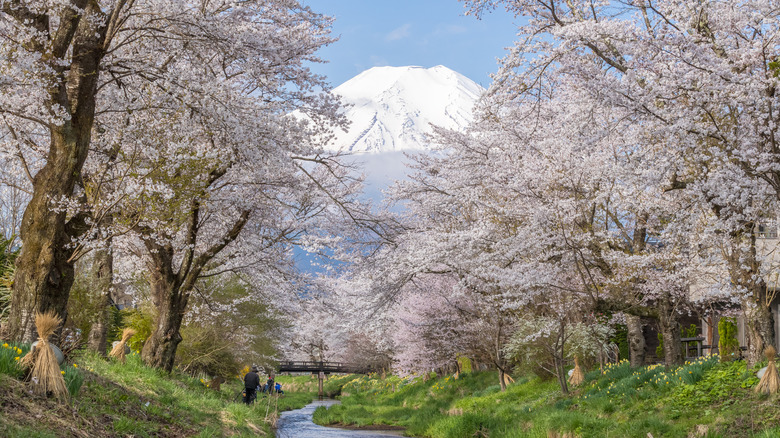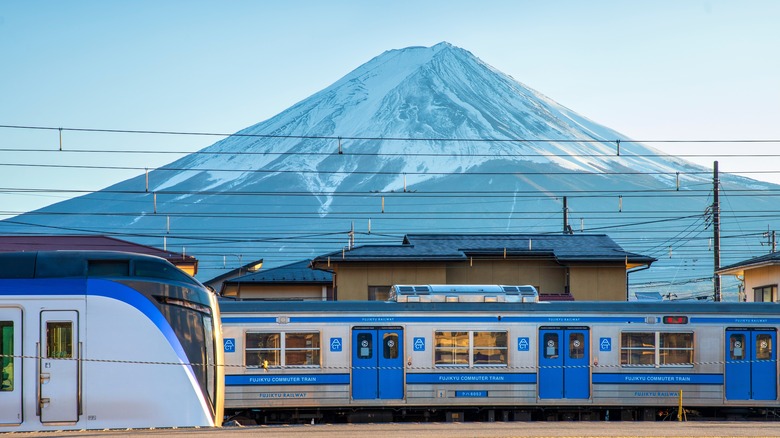Japan's Most Beautiful Mirror-Like Lake Near Mount Fuji Offers Scenic Views Of Lush Cherry Blossoms
The bloom of Japan's iconic pink cherry blossoms, or sakura, is so much of a cultural phenomenon that a specific word exists to describe the act of enjoying their petals: hanami, meaning "flower viewing." And there's no better way to view these stunning blossoms than with the backdrop Japan's most famous landmark, Mount Fuji. Spread around the base of this still-active volcano is a cluster of five lakes known as Fujigoko, or the Fuji Five Lakes — and the most famous of these is Lake Kawaguchi, where the view of Mount Fuji rising up across the water, according to many reviews on Tripadvisor, is a "sight to behold." On clear days, the lake is known to be so calm you might be able to see Mount Fuji reflected across its surface.
Lake Kawaguchi has grown in popularity as a tourist destination thanks in part to social media. Aesthetic Instagram posts of Mount Fuji towering behind the roof of a popular Japanese convenience store chain had travelers flocking to that particular location in Lake Kawaguchi on a daily basis to recreate the photo. The cherry blossom spots around the lake itself, however, are just as impressive and aesthetically pleasing, and several locations are easily reachable by public transportation. Early spring will be the best time to catch the cherry blossoms. The trees around Lake Kawaguchi reach their peak bloom during the middle of April, lasting for roughly two weeks.
Being located just under two hours outside of Tokyo makes Lake Kawaguchi an easy day trip from the capital, especially to see cherry blossoms away from packed crowds that routinely swarm the city. The surrounding resort town, called Kawaguchiko, is also bustling with hot spring baths, outdoor activities, and cultural attractions that make staying overnight worth it too.
Best places to see cherry blossoms around Lake Kawaguchi
The northern shores of Lake Kawaguchi offer some of the best panoramic views of cherry blossoms in the country and are only around 20 minutes away by local bus from Kawaguchiko Station, the lake's main transport hub. Along the banks is a scenic walking trail flanked by around 200 cherry trees with Mount Fuji in the distance, a truly unforgettable scene. During the first two weeks of April, this walking trail also serves as the location for the annual Fuji-Kawaguchiko Sakura Festival, a charming local event with craft markets, a stamp rally, and evening illumination of the surrounding cherry blossoms, all free to enter. To get here, take the Kawaguchiko Red Line Bus and get off at the Konohana Art Museum bus stop. Just a 15-minute walk away is Nagasaki Park, another popular spot to take iconic photos of the cherry blossoms framing Mount Fuji across the lake.
Along the eastern shores, a small peninsula juts into the lake, called Ubuyagasaki. This is another great place to see fully bloomed cherry blossoms, this time with a view of Kawaguchiko Ohashi Bridge stretching over the water toward Mount Fuji. You can get here in roughly 15 minutes from Kawaguchiko Station by taking the Red Line Bus and getting off at Kozantei Ubuya bus stop, then walking westward along the shore for about four minutes until the main road reaches a tunnel, where you'll see a small path leading to the left. Benches along the path let you sit beneath the cherry trees to fully admire their beauty. After a day full of flower petals, you could take a ride in a cable car on the Mt. Fuji Panoramic Ropeway, where an observation deck gives sweeping views of Mount Fuji and Lake Kawaguchi down below.
What else to do at Lake Kawaguchi
While you're in the area, definitely take some time to see the unmatched views of the sacred village Oshino Hakkai, where a tranquil river is bordered on both sides by a walking path with lush cherry blossoms. A bridge at the far end of the stream offers a memorable view of Mount Fuji between the rows of blooms. Oshino Hakkai is easily reached from Kawaguchiko Station by taking the F-Line Fujikko-Go Bus and getting off at the Oshino Hakkai bus stop, a short distance away from the start of the walking path.
Weeping cherry blossoms, with their graceful tendrils of delicate pink flowers, are an especially beautiful sight in the springtime. Stop by the charming village of Iyashi no Sato for a gorgeous scene of these fully bloomed branches cascading between the thatched roofs of traditional Japanese-style farmer's cottages. About 40 minutes away if you take the Omni Bus Green Line from Kawaguchiko Station, the village is an open-air museum where the cottages have been converted into restaurants, art galleries, and shops with local handcrafted products like pottery and incense.
For a more outdoorsy experience, there are plenty of camping opportunities around Lake Kawaguchi. Retreat Camp Mahoroba has options like pitched tents or a private cottage, plus shower facilities including a sauna and jacuzzi. PICA Fujiyama has an even more upscale campsite, where you can sleep inside spacious transparent domes and wake up with Mount Fuji at your doorstep. Thrill-seekers also shouldn't miss a visit to Fuji-Q Highland, a nearby amusement park with speedy rollercoasters that twist, turn, and drop at frighteningly steep angles, just a few stops before Oshino Hakkai on the same bus route from Kawaguchiko Station.
Planning your trip to Lake Kawaguchi
The most convenient way to reach Lake Kawaguchi from Tokyo is by bus. Buses depart at regular intervals from the main terminal next to Shinjuku Station, making a few stops along the way before terminating at Kawaguchiko Station. It's recommended to reserve your bus ticket a few days in advance, as it's a popular route and seats sell out fast. Fares for a single trip are around $14 per adult, and $7 for a child at the time of writing. Another way to get there is by train — also departing from Shinjuku Station, travelers can take the Fuji Excursion train to Kawaguchiko Station, with tickets costing roughly $27 per adult for a one-way trip at the time of writing. Both the bus and train journeys are just under two hours long.
Another important consideration is that even on clear days, it may not be guaranteed that Mount Fuji will be visible — clouds tend to gather and obscure the mountaintop in the late afternoon. Early morning hours are normally the best for visibility, so an overnight stay would put you at an advantage to see this iconic landmark at its most impressive. Aside from camping, Kawaguchiko has plenty of conventional hotels and traditional Japanese-style guesthouses for a cozy night, many of which have excellent views of Mount Fuji.
Lastly, the more flexible you can be with your travel plans, the better — the precise time when cherry blossoms begin to flower can be unpredictable, and although the Japan Meteorological Corporation publishes regular forecasts, any slight change in the weather can delay or accelerate the full bloom. When deciding on your visit to Japan during the springtime, make sure to read up on how best to plan your trip to see the cherry blossoms.



